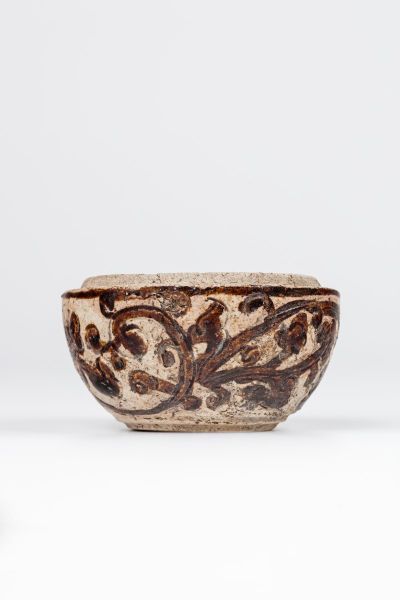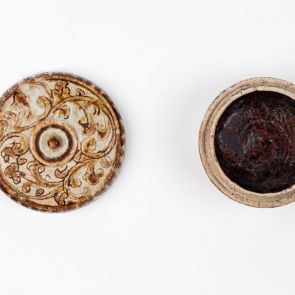
Lidded box
Sawankhalok ware with brown and mother-of-pearl glaze, incised. Brown (or its inverse) leaf motifs on a white base are a characteristic decorative feature of this type. At the time, the lid probably belonged to another, slightly larger pottery.
In the former town of Sawankhalok in northern and central Thailand, the pottery industry developed enormously in the period from the 14th to the mid-16th century.
This was in part due to the sudden ban on the export of Chinese ceramics in 1371, during Ming dynasty rule. It was at this time that Vietnamese and Thai ceramics took the place of Chinese ceramics in Southeast Asian markets.
Typical pieces of the type were celadon glazed ceramics, learned from Chinese masters, but other types of glazed ceramics (underglazed iron, brown monochrome, brown and mother-of-pearl incised, white monochrome, black monochrome, olive monochrome) also existed, not to mention their unglazed counterparts.
The pieces known today have been found partly in field excavations and partly as cargo from sunken shipwrecks.
In the former town of Sawankhalok in northern and central Thailand, the pottery industry developed enormously in the period from the 14th to the mid-16th century.
This was in part due to the sudden ban on the export of Chinese ceramics in 1371, during Ming dynasty rule. It was at this time that Vietnamese and Thai ceramics took the place of Chinese ceramics in Southeast Asian markets.
Typical pieces of the type were celadon glazed ceramics, learned from Chinese masters, but other types of glazed ceramics (underglazed iron, brown monochrome, brown and mother-of-pearl incised, white monochrome, black monochrome, olive monochrome) also existed, not to mention their unglazed counterparts.
The pieces known today have been found partly in field excavations and partly as cargo from sunken shipwrecks.
